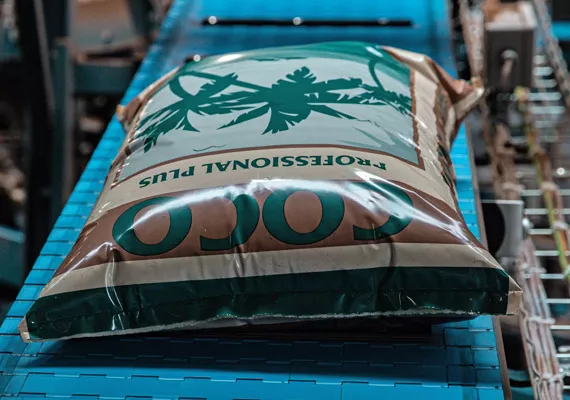Coco coir is the name given to the natural fibre extracted from coconut husks. It has long been used in the manufacture of brushes, stuffing for automobile seats and mattresses, drainage pipe filters, twine and other products. However, the very short fibres (measuring 2mm or less) and dust that were left behind were once considered a waste product for which no industrial use had been discovered.
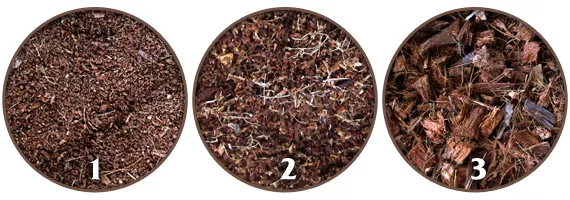
What is coco coir?
At first glimpse, coco coir looks like soil, but it is actually a by-product of processing coconut husk fibre. Coco coir is the name given to the fibrous material that can be found in middle layer of the coconut fruit (Cocos nucifera).
Three main horticultural coir products can be obtained from this husk; coir chips, coir fibre or coir pith/dust (see picture 1). The coir dust retains water well, while the fibres and chips help to create pockets of air and drainage. Coco coir consists primarily of particles in the size range 0.2-2.0 mm (75-90%), and unlike a medium like sphagnum peat, for example, it is free of extraneous organic matter like wood or leaves.
Physical and chemical characteristics
Coco coir, mainly coco dust, is the major constituent of most coir products and it is made up of millions of capillary micro-sponges that absorb and retain up to nine times their own weight in water. As a substrate, it is well-aereated and compaction after drying is minimal. It has a natural pH of around 5.7 to 6.5, plus a high cation exchange capacity or ‘CEC’ which makes it good but challenging substrate for hydroponic cultivation.
Now what exactly do we mean by ‘CEC’? It all comes down to how easily the substrate releases nutrients that can then be taken up by the plant’s roots. In order to understand this, we should think of the substrate as a storehouse for plant nutrients. The relative ability of the substrate to store a particular group of nutrients – called cations – is called the cation exchange capacity or CEC of that substrate (see picture 2).
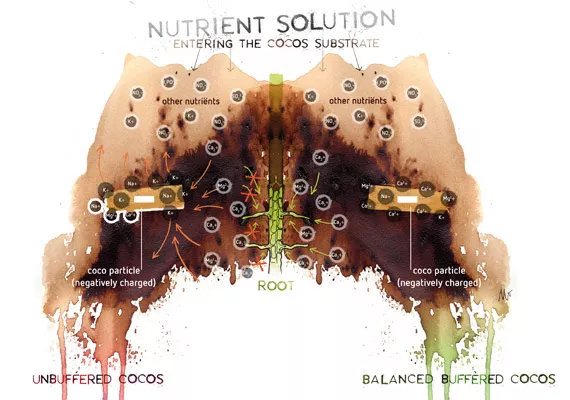
Coco substrate that has been pre-treated in this way is unlikely to release excess potassium or bind the calcium and magnesium that the plants need. The result: healthy plants with no symptoms of nutrient deficiency.
Washing and buffering
Coco coir, in its unprocessed form, tends to be high in both sodium and potassium compared to sphagnum peat. We know that the sodium can easily be leached from the material using irrigation. Potassium is also released and becomes available for the plants. Unfortunately, bivalent ions like calcium and magnesium then bind to the coco particles instead. This may result in excess levels of potassium, and a simultaneous deficiency of calcium or magnesium.
Of course, this is something that growers need to avoid and to prevent it from happening the coco substrate is often washed thoroughly to leach excess sodium and chloride. It is then pre-treated with a calcium fertiliser such as calcium nitrate to enhance the potassium-calcium exchange. This process is called buffering and it produces a coco substrate that is not likely to release excess potassium or bind the calcium and magnesium required for plant growth.
Properties of coco coir during cultivation
Plants grown in coir can develop large roots, stems and blooms. Unlike regular potting soil, which can easily become compacted, coco coir retains plenty of air pockets leaving room for the root system to grow. This gives rise to a healthy aerobic rhizosphere – essential for good uptake of nutrients and water. Some crops like tomato or sweet chilli may tend to grow more vegetatively, meaning that the plants will look healthy and grow fast and strong but will actually produce relatively fewer flowers and fruits. For growers, this is something to be avoided, of course, because they will want to maximize their harvest. As you can read in our other article on coco, small adjustments in the fertilisation regime can resolve these problems.
Coco coir has a naturally high lignin content which encourages beneficial micro-organisms around the roots and discourages decomposition, making it an ideal growing media for reuse.
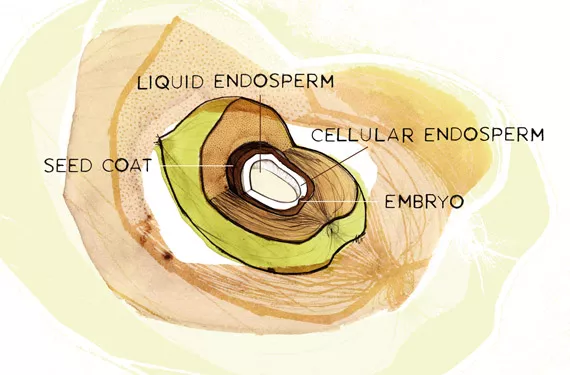
It is also thought that the occurrence of favourable micro-organisms acts as ‘protection’ against plant pathogens. This was demonstrated in several experiments conducted in vitro which showed that coco coir suppressed the growth of soil-borne plant pathogens. One of these experiments showed that mycelia growth in the fungus of Phytophthora capsici was strongly inhibited when the growth medium was adjusted with an unsterilised coir suspension.
The results from different studies suggest that coir can suppress soil-borne plant pathogens in vitro and this ability is largely due to micro-organisms associated with the substrate. We now know that the famous Trichoderma fungus plays a key role in the ability to suppress plant pathogens, but the benefits of these micro-organisms during crop cultivation are still largely unknown.
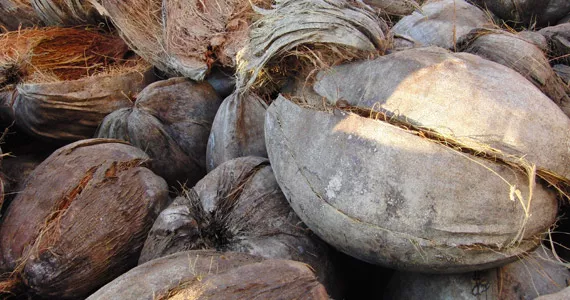
Coco coir as an alternative for peat
In this article we have focused on coco coir as a stand-alone substrate. However, coco coir is also used as a replacement for sphagnum peat in peat-based substrates.
For almost a quarter of a century, coco coir has also been tested as a candidate to replace sphagnum peat, sedge peat and to a large extent rock wool plugs as a germination and nursery medium for broccoli, tomato and lettuce seedlings. It was found that germination occurred earlier in coir and tomato seedlings grew bigger and more uniformly.
It is actually very probable that some countries will ban the use of peat as a substrate within the next few decades, because our supplies of peat are not endless and extracting it is not an environmentally friendly process.
The coco substrate as a growing concept
The whole concept of coco substrate, both its benefits and its disadvantages, will require adjustments to the nutrient composition and regime. CANNA was among the first manufacturers of specialised coco nutrients to come up with solutions for the release and binding of plant nutrients.
These days, coco coir is a very promising substrate. It is sustainable, it can be re-used easily, and ample research has shown that coco coir has a natural ability to suppress plant diseases. The other side of the coin, however, is that coco coir requires specific nutrient adjustments to compensate for the natural binding of calcium and magnesium and the release of mainly potassium. Unfortunately, we still know little about the benefits of disease-suppressing properties during crop cultivation.
